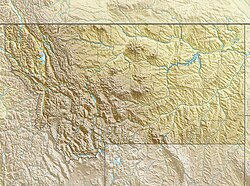| UTC time | 1925-06-28 01:21:12 |
|---|---|
| ISC event | 910562 |
| USGS-ANSS | ComCat |
| Local date | 27 June 1925 |
| Local time | 17:21:12 |
| Magnitude | 6.9 Ms [1] |
| Depth | 15 km (9 mi) |
| Epicenter | 46°22′N111°25′W / 46.37°N 111.41°W |
| Areas affected | Montana, United States |
| Total damage | $150 thousand |
| Max. intensity | MMI IX (Violent) |
| Foreshocks | 1 possible, magnitude unknown |
| Aftershocks | 75+ |
| Casualties | 2 injured |
The 1925 Montana (Clarkston Valley) earthquake occurred at 17:21:12 MDT on 27 June in Montana, with the epicenter being located near Townsend. The earthquake had a magnitude of 6.9 in the surface-wave magnitude scale. A maximum intensity of IX (Violent) was observed. Serious damage was reported near the epicenter. 3 hours after the mainshock, a strong aftershock was recorded with an unknown magnitude that also caused damage. [2]

